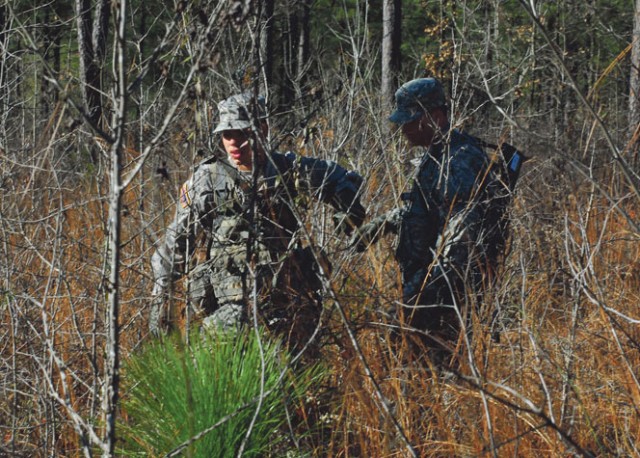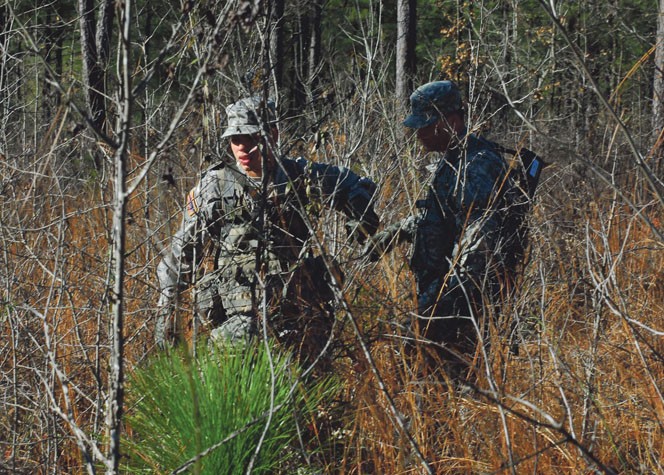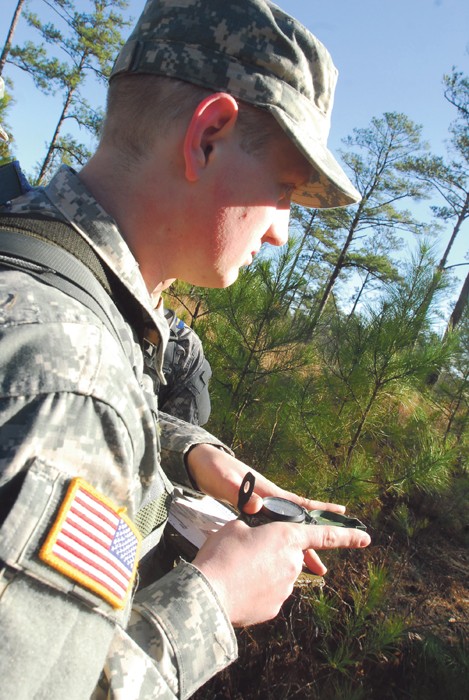FORT BENNING, Ga. - Batteries can die, signals can fade and global-positioning equipment can malfunction at inconvenient times. That's why Soldiers with B Company, 3rd Battalion, 47th Infantry Regiment, 192nd Infantry Brigade, spent Tuesday in the woods armed with compasses and maps.
"Electronics break down, computers aren't always guaranteed," said SSG Lance Walker, a drill sergeant with B Company. "These Soldiers need to know how to orient themselves with a map. It's always good to know where you are and what your mission is."
The Soldiers learned the basics of map reading and using a compass Monday before setting out on the 1.5-kilometer navigation course on Sand Hill Tuesday. The course contains 53 points spread out among forested, uneven marshland. The Soldiers, in squads of five, had to find three out of five assigned points in order to complete the day portion of the training and two out of three points during night navigation, said SFC Matt McMurray, a drill sergeant with the company.
Several "Gladiators" Soldiers from 1st Platoon said the training would help them in their future careers.
"We could be out in the desert lost in Iraq," said PV2 James Van Hoet, who is training to become a petroleum specialist.
"If we're Airborne and they drop us out of a plane, we'll need these skills in order to get to the objective," said PFC James Henry, who plans to become a network switching systems operator maintainer.
PVT Patrick Spray, who signed up for field artillery, summed up the importance of accurate map-reading in his specialty with eight words, "Miss by an inch, miss by a mile."
Land navigation training is not a graduation requirement; however, all Soldiers should be exposed to it, said CPT Jon Lindsley, the company's commander.
"Everybody in the military needs to know how to read a map and be able to move from one point on the ground to another," he said.
Lindsley said the land navigation training marks the last week of red phase - the first of three three-week phases the Soldiers must get through to graduate.
"They are at the end of the "still shocked I'm here" phase," he said. "Some of them are already enjoying (training), some not so much."
Lindsley said he expects the excitement in the troops will pick up Wednesday with the introduction of Basic Rifle Marksmanship.
The Soldiers graduate March 18.
----
Where are we'
Sure, a GPS can easily tell you where you're at without the hassle of plotting out points on a map, shooting back azimuths on your compass and scanning the horizon for terrain clues. But what happens if that handy-dandy GPS stops working on your next hunting, hiking or geo-caching trip'
SSG Lance Walker shares why it's important to know the basics of land navigation. He has firsthand experience with relying on maps to get out of a sticky situation.
While deployed to Iraq, Walker said he was in a convoy traveling along Main Supply Route Tampa - nicknamed "IED alley" and a common ambush site - when the electronic tracking systems the convoy was using to get directions to its next checkpoint went down.
"The second the systems went down, we pulled our maps out and plotted our points," he said.
Walker said the convoy was able to get back on track with minimal delay.
He said his experience emphasized the importance of not relying solely on electronics for directions.












Social Sharing